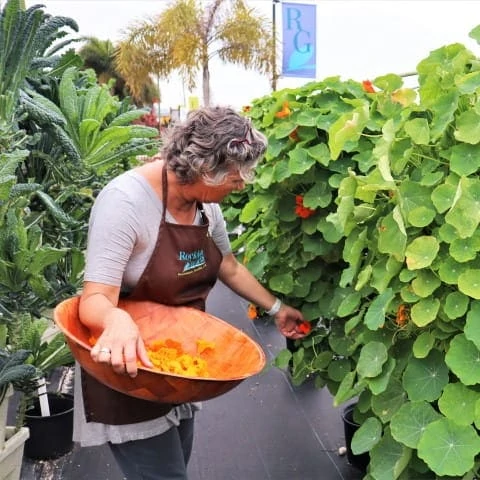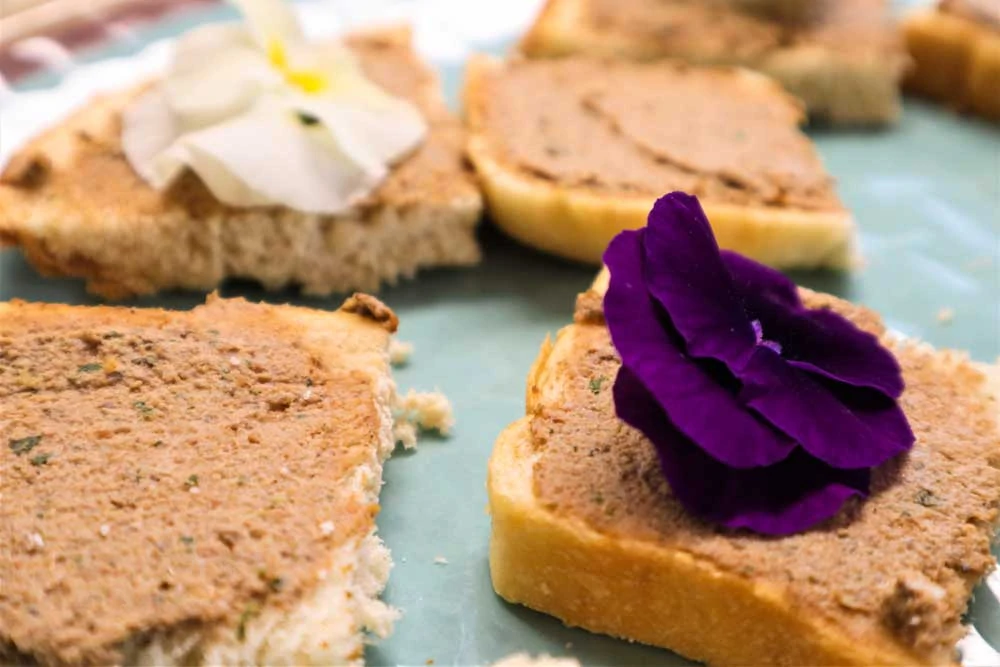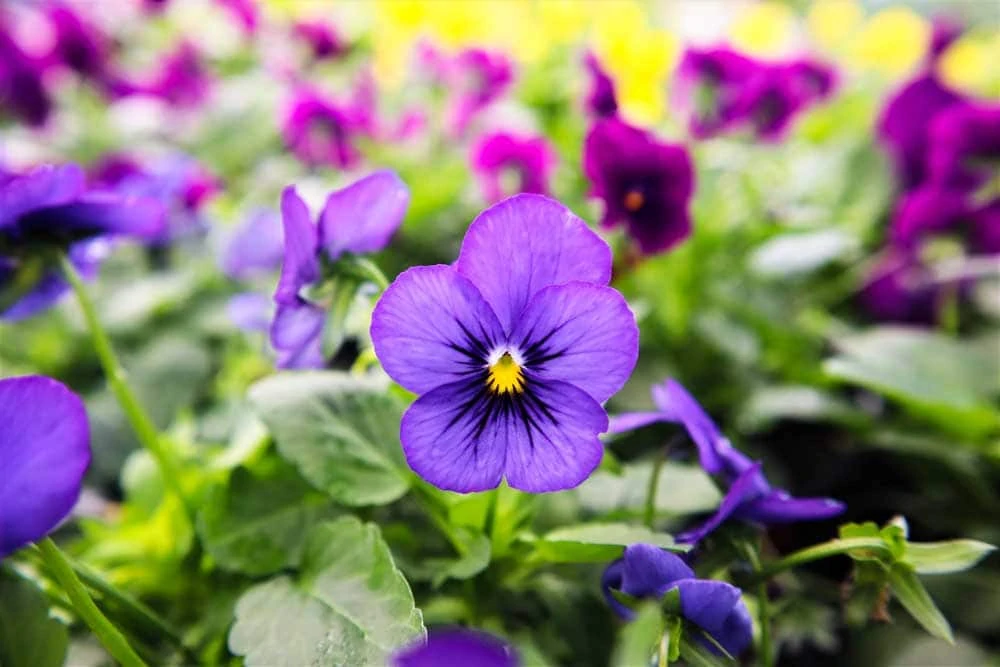by Amanda Rose Newton

While the official first day of the new season started last week, spring fever has been in effect here for months! From the beautiful weather and the smell of freshly-turned dirt, to the promise of fresh fruits, vegetables, and flowers, spring is the most inspiring time to be in the garden. Those extra few hours of daylight we have been receiving the last few weeks are certainly helping with that vibe.
Dining alfresco at this time of the year is a must in Brevard county. We are still a few weeks away before the soul-sucking heat and mosquitoes crash the party, making this timing perfect for cocktails with friends (six feet apart, of course). In fact, you can capture the beauty of your freshly planted landscape in a glass with assistance from edible flowers.
What makes a flower edible?
Edible flowers are making a comeback in the culinary world after a long absence. The Victorian era, also famous for using flowers as a language, saw the high point of flowers used in high cuisine. They can be used as a garnish, as a main part of the meal, or dipped in sugar to be used in pastries and cakes. The secret of getting the most out oomph is to make sure the backdrop doesn’t dominate the delicateness of the flower.
As you probably guessed, not all flowers work out in culinary practice. First and foremost, many flowers contain chemical compounds that can make you ill, so think twice before random sampling from the yard. You also want to take care that the flowers you are using for cooking come from a pesticide/herbicide-free environment.
For herb flowers, less is more! They often taste similar to the more commonly consumed leafy portion. Below is a short list of edible flowers that are as easy to grow as they are to enjoy.
Top 6 Easy Edible Flowers To Grow

1. Borage- Old fashioned but forever beautiful in blue, borage is a classic edible flower that cheers up any garden. The flavor is similar to that of cucumbers; light, crisp, and softly fragrant. Bees have a soft spot for borage and will certainly visit your garden if planted. A robust annual, it will reach about 3 feet tall with a 2-foot spread. It performs best in full sun but will tolerate part shade. Flowers and leaves of the plant can be harvested throughout the season.
2. Marigolds- Perhaps thought of as typical, marigolds are anything but! Their feathery foliage and sunny flowers double as an attractant to bees and beneficial insects and deter many unwanted pests. In the culinary arena, they are often the understudy for saffron, due to their distinct, musky, citrusy flavor. The perfect addition to a spring salad, marigolds get about 2 feet tall with a 2-foot spread and do well in full to partial sun.
3. Nasturtiums- The classic edible flower, nasturtiums are featured in haute cuisine worldwide. You can stuff them with savory cheeses or tapenades or simply use the leaves to add peppery flair to an everyday salad. The seeds can even be pickled and can make for a nice caper substitute on short notice. With hundreds of cultivars available, colors range from white to blood red, which will make the side salad the star of the meal. Nasturtiums are easy to grow in window boxes, trough planters, or even as a vine given their trailing habit. They like to spread out, but share space well when planted in containers with other upright herbs like rosemary.
4. Pansy- Violas, those happy little bright colored flowers we all love, are equally as at home resting on top of a frosted cake as they are in your garden bed. You can easily make your own sugary confections by dipping fresh flowers into warm simple syrup and allowing them to dry. Pansies grow best here in Brevard during the spring months, before intense summer heat sets in. Heights and spacing vary, but they do well in-ground, in containers, as well as mixed into a raised garden bed.

5. Impatiens- These annual bed staples make excellent garnishes for both the plate and the glass. Nothing makes a cocktail more enticing than a beautiful flower! Their pastel colorway vibes perfectly with the Easter holiday this weekend! Like pansies, impatiens are just as at home in a small container as they are planted as the focal point of an annual flower bed.
6. Wax Begonias- Loved for their dark green foliage and shade-loving nature, both the leaves and the flowers are edible. Thanks to oxalic acid, begonias have a unique sour taste that fits in nicely with vinegary dressings and fermented foods. Begonias perform best out of direct sunlight in moist areas.
BONUS: Squash blossoms! If you are growing squash (that includes summer, fall, and zucchinis) the blossoms make excellent edible flowers. Like nasturtiums, they can be stuffed with pate or used as a beautiful low-carb wrap for tacos.
To close out our month of botanical mixers, it seems fitting to pay an homage to the garden, the bearer of the beauty of the season.
The Gin Gimlet is a classic for a reason (and it also happens to be our Managing Director’s favorite cocktail of all time). The effortless combination of lime, sugar, soda, and gin offers simplicity at its best and there is certainly room for individual creativity. By replacing the gin with anything you crave, be it lime seltzer, or an herbal infused simple syrup, you can add your own spin to a drink that is sure to be a hit. Throw in a few of the edible flower ice cubes below, and you have a full-fledged garden party! This is truly the Gardener’s Drink!
The Gardener’s Gimlet
1 tbsp fresh lime juice (key lime recommended)
1 tbsp mint or basil simple syrup
6 basil or mint leaves
Club soda or seltzer
Borage Ice cubes
For the simple syrup:
1 cup water
½ cup sugar
½ cup fresh mint or basil leaves
Directions:
Make Syrup:
1. Bring sugar and water to a boil in a small saucepan
2. Add the mint or basil
3. Reduce to a simmer until syrupy
4. Transfer to a glass container and store long term in refrigerator
For the Drink:
1. Add the fresh herb leaves, lime juice, and simple syrup to a glass
2. Use a muddler (or the handle of a wooden spoon) to break up the herb leaves, releasing the oils
3. Fill the glass with ice (make sure the pretty borage ice is on top) and top with soda water or seltzer
Edible Flower Ice Cubes
This is so easy you will want to do this every time you make ice! Simply fill the ice cube trays half full with water, drop in a borage blossom and top off with water. Proof that elegance can be easy.


